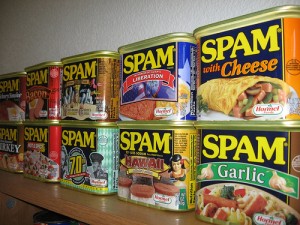Once, the name of a cheap lunch meat, spam has now become synonymous with unwanted advertising. In order to fight this, the US Congress and the FCC passed CAN-SPAM laws, designed to help consumers manage their email inboxes, and stop unwanted email.
The original law, signed in 2003, was called: Controlling the Assault of Non-Solicited Pornography And Marketing Act of 2003 (or CAN-SPAM. The legislation was later modified in 2008.
The act regulates commercial email messages, which is an email message meant primarily to promote or advertise a product or service. It can be e-books, jeans, flowers, anything.
CAN-SPAM is really opt-out, not opt-in.
It does not require opt-in (explicit permission to send emails). In fact, before CAN-SPAM, many marketers (at least the reputable ones) worked very hard to get permission before sending emails.
There was a raging debate (still is) over whether single opt-in (sign up and you’re on the list) or double opt-in (a two-step process requiring that you first sign up and then confirm it) was required.
What the email law mostly does is focus on rules for opting-out (removing yourself from email lists).
It does not require opt-in (explicit permission to send emails). In fact, before CAN-SPAM, many marketers (at least the reputable ones) worked very hard to get permission before sending emails.
There was a raging debate (still is) over whether single opt-in (sign up and you’re on the list) or double opt-in (a two-step process requiring that you first sign up and then confirm it) was required.
What the email law mostly does is focus on rules for opting-out (removing yourself from email lists).
email marketing best practices and can-spam rules
Here’s what CAN-SPAM does require you to do.
You must:
- Include a visible, working method to unsubscribe (opt-out).
- Remove names from your list within 10 days of receiving the request.
- Maintain an opt-out (suppression) list. In other words, once people opt-out, you may not mail to them again (except to confirm the op-out), either directly or indirectly.
- Accurate “from” and header fields (you can’t conceal where the message came from, or spoof someone else)
- The subject lines must be relevant and can’t be deceptive
- The message must include a legitimate physical address (this can be a street address or a P.O. Box).
- Remove people for free. You cannot charge a fee or ask for any information other than an email address to process the opt-out request.
- Make it easy to opt-out. There should only be a single step, either an email reply message saying “unsubscribe” or “remove” or a visit to a single web page.You cannot require people to login to their accounts.
- If more than one company is sending a message, one of them must take responsibility for complying with the rules.
- Follow the rules whether the sender is a single individual, a corporation, or several corporations or businesses.
- Remove people who ask from your list, and from the lists of any of your business subsidiaries or marketing partners. If someone opts out from messages from The Gap, and The Gap shares its list or does a co-promotion with Banana Republic, they have to make sure you don’t get that email either unless you say otherwise.
You can allow subscribers to adjust their preferences (removal from newsletter A, but not newsletter B), or offer them less frequent emails.
Transactional messages (such as confirming your order, or acknowledging receipt of an email) are exempt, as are emails to existing customers (unless they opt-out, or specifically say “stop”!)
Best way to email your prospects
A web designer on LinkedIn just asked if it was OK for a client to send a new email newsletter to a list of potential prospects.
During her initial meeting with the client, she correctly told them that reputable email marketing services require opt-ins.
After the meeting, she did more checking and found, to her surprise, that opt-in is not required by CAN-SPAM.
She wanted to know if there was an ethical way to send unsolicited email to a list. Or was that a really bad idea.
CAN-SPAM encourages more spam
She’s right. It’s technically legal to send emails without permission, under CAN-SPAM.
In fact, CAN-SPAM actually encourages more spam. Before the law was passed, marketers worked very hard to get permission to contact people via email.
There was a great deal of debate over whether single opt-in (just enter your email address) or double opt-in (type your address, and confirm it) was required.
Technically right doesn’t mean ethically correct
So, it’s technically OK, as long as you include your physical address, provide an opt-out link, and use a real email address.
It may not legally be spam, but the people who get it will perceive it that way. Your message is more likely to get bounced, blacklisted, or stuck in spam filters.
One reason for using AWeber or Mail Chimp, is because they have a high delivery rate, are a recognized legitimate mailer, and will also manage opt-outs, bounces, etc.
And, before you send email to any list, make sure you know where it came from. Did you “buy” it (the quality is probably poor, and the names scraped from contact information on the Internet, or build it yourself? Were those names collected recently? If they’re from the design conference you went to in 2008, they’re no good. Those people have forgotten about you. If you email them, they will probably think it’s spam.
Image: brownpau
P.S. My free ebook “Email Marketing Made Easy” has lots more tips about email done right. You can download it here. No registration needed.





 Email is quick, easy, and fairly cheap. Done right, it’s a great way to get more leads and more sales. Done wrong, you can annoy your customers or get labeled a spammer.
Email is quick, easy, and fairly cheap. Done right, it’s a great way to get more leads and more sales. Done wrong, you can annoy your customers or get labeled a spammer.